BIOL 240 - Midterm 1
1/58
Earn XP
Description and Tags
Topics 1 - 4
Name | Mastery | Learn | Test | Matching | Spaced |
|---|
No study sessions yet.
59 Terms
Robert Hooke’s vs. Antoine van Leeuwenhoek?
Hook was the first to describe fungi.
Leeuwenhoek was the first to provide a written discription of bacteria.
What are the core features of life? How are they achieved?
Metabolism, Growth, & Reproduction
Achieved through genetic variation/evolution, response/adaptation, & homeostasis.
Heterotroph vs autotroph.
Give an example of how they get energy and how they can help in biogeochemical cycling.
Heterotrophs ingest organic molecules to get energy, & Autotrophs produce organic molecules.
Ex. organic molecules are broken down by microbes to harness chemical energy (ATP) through fermentation & aerobic respiration. Can help in biogeochemical cycling as they interact with the environment by cycling inorganic to organic molecules and back.
Which macromolecule is more in the cell? Which is the least?
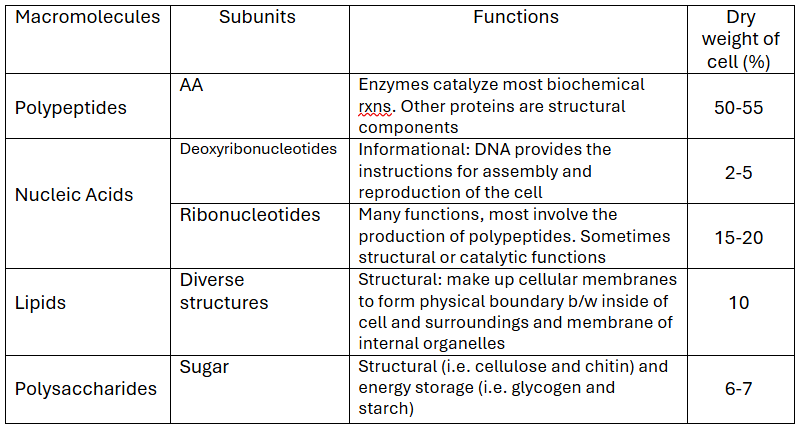
What is the phylogenetic tree divided into?
Who was it made by?
What is it based on?
The phylogenetic tree is divided into Bacteria, Archaea, & Eukarya. It is based on the ribosomal RNA sequences.
The Archaea are more closely related to the Eukarya
It was created by Carl Woese.
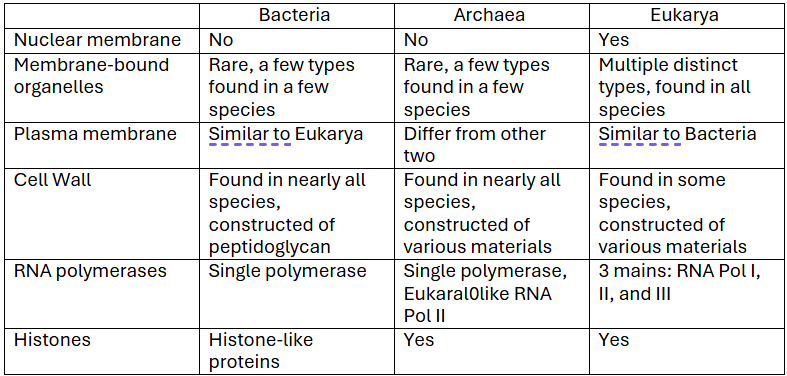
What features make SSU rRNA gene sequences ideal for phylogenetic (or evolutionary history) studies?
Compare protein sequences to reveal evolutionary relationships. The more similar the AA sequence = the more related the organisms are. rRNAs have a universal presence in all cells so they can be used to easily compare.
Specifically, SSU rRNA are “molecule chronometer” as their sequences change very slowly b/c of the functional constrains on the molecule. Random mutations are dangerous, so it does not change when passed to further generations.
Founded by Woese
Are viruses considered alive? Why?
Not considered alive as they cannot replicate outside the host cell, have little biochemical activity outside a host cell, and are inert and nonreactive outside the host cell. ARE NOT MADE OF CELLS
What were the early Earth conditions?
Harsh with little O2 in the atmosphere
High temps
Significant amounts of H2O, CH4, HCN, CO2, N2, H2, NH3
Planet surface was a chemical soup w/ a reducing atmosphere
Energy input from various sources, including UV light.
UV irradiation of gaseous mixtures resembling Earth’s early atmosphere can result in the formation of organic macromolecules
What was Miller and Urey’s experiment?
To stimulate the spark that might have started forming organic molecules from the primordial soap. Added their own gasses like CH4, NH3, H2O, H2.
What were the requirements of early life? Give 2 examples that we can see this in.
Genetic info storage, the ability to catalyze biochemical rxns & a way of separating the cell interior from the external environment.
This can be seen in ribozymes (RNA behaving like enzymes) as they catalyze rxns, store genetic info, and can self-replicate & micelles as they may have been an early form of plasma membranes, with a polar head and non-polar tails, creating a bilayer.
The RNA World
For the formation of Earth to start the origin of life, there was much chemical evolution and synthesis of biomolecules. There was also much failure before there was success
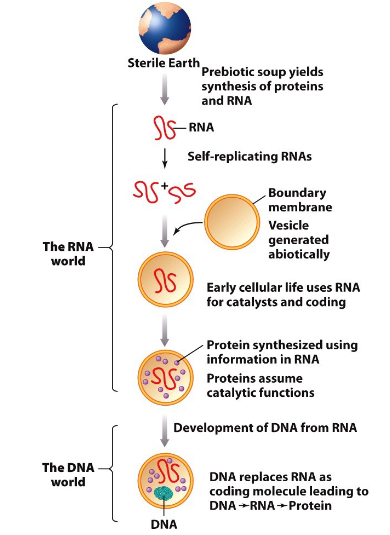
What are the features of LUCA
Using ATP as chemical energy
DNA to RNA to protein
eating CO2 & fixing N2
Anaerobe (no need for O2)
Thermophile (high temp lover).
Autotroph and H2 oxidizer.
As oxygen was scarce, how could we circumvent the readily oxidized electron donors away from hydrothermal vents? How is this known?
Ancestors of cyanobacteria were able to solve this problem by extracting the e- from the water and creating O2 as a toxic byproduct - oxygenic photosynthesis.
This is known because multicellular fossils from billions of years have been found fossilized into stromatolites due to precipitating carbonate.
How did Earth evolve into so many microbes & microorganisms?
It was the physiology of the existing microorganisms that created the environmental conditions conducive to the rise of multicellular organisms, which then evolved from microorganisms.
What was the early coding material? How did it become to this?
Early coding material was RNA.
Coding material developed the ability to direct peptide synthesis resulting in catalytic activity, which replaced RNA.
The genomic function of RNA → DNA.
What are the 2 different perspectives for examining microbial genomes?
Examining effects of single mutations in DNA individually (microbial genetics)
Studying and comparing pieces of genomes to each other across domains (phylogeny)
a. this makes it like a cobweb of intertwining connections b/w generations
What is the endosymbiotic theory? What is the evidence?
Explains how ancestral archaeal organisms swallowed aerobic bacterial organisms to for a symbiotic relationship through protection and a steady supply of nutrients. Created mitochondrion & chloroplasts.
Evidece is that eukaryotic organisms w/o organelles are near the root of tree & rRNA of mitochondria and chloroplasts are similar to bacterial rRNA than eukaryotic.
What did Pasteur do?
living organisms discriminate b/w optical isomers
explained biological nature of alcohol fermentation by extending shelf life - pasteurization
vaccines for anthrax, fowl cholera, and rabies
introduced sanitization in hospitals
molecules have chirality
disprove spontaneous generation theory
What did Koch do?
determined Bacilus anthracic was the cause of anthrax & mycobacterium was the cause of tuberculosis
established Koch’s postulates
What are the Koch’s postulates?
What do they prove?
Koch’s postulates can be used to show a specific microbe causes a specific disease. The cause and effect are proven if:
The suspected microbe is identified in every person with the disease, but not those that are healthy
Isolate the suspected microbe/pathogen in a pure culture
Take the pure culture, inculate it into the animals and show that they develop the disease
Get the pathogen that was experimentally inoculated into the animal to prove that the pathogen is the cause of the disease
NOTE: not always possible to apply his postulates
Bacteria shape
spherical = coccus
rod-shaped = bacillus
comma-shaped
spiral
pleiomorphic (varied shapes)
Morphology may be determined by what selective forces?
Nutrient uptake efficiency (surface to volume ratio)
Spirals allow efficient swimming in viscous or turbulent fluids
Gliding motility (filaments)
What are the usual sizes of cells?
Prokaryotes are 0.2 - 700 um in lnegth/ diameter.
Rod-shaped bacteria b/w 0.5 um - 4.9 um wide and 1-15 um long.
The min size is simply due to minimum space requirements for genome, proteins, and ribosomes.
What are exceptions to the general size of bacterial cells.
Thiomargarita namibiensis - up to 700 um
Epulopiscium fishelsoni - up to 600 um
Thiomargarita magnifica - > 9000 um
What are the advantages of being small?
Being small allows for high surface to volume ratio, the greater rate of nutrient/ waste exchange per unit volume, supports higher metabolic rate, and supports faster growth rate and faster evolution
What are the limits of being small?
Limits include size reduction constrained by the min complement of cellular structure and very small cells are common in open marine environments. Can only contain few ribosomes and proteins but can’t do a lot of things. Most are parasitic and rely on the host to live.
What is the largest area inside the bacteria?
The nucleoid region is the largest area. It houses chromosomes and DNA replication machinery. It does not contain a membrane surround the nucleoid and no histone proteins.
How and why is DNA compressed in the bacteria.
DNA repels one another due to its structure and charge. It reduces space by using cations to shield negative charges on the phosphate backbone using small, positively charged proteins that bind to the chromosome to maintain the condense structure. Topoisomerases modify the structure of DNA to enable supercoiling.
What is inside the cytoplasm of a bacterium?
It contains macromolecules (i.e. tRNA, rRNA, etc.), inclusion bodies & microcompartments
Sulfur globules: sulfur storage for energy - IB
PHB granules & Glycogen: carbon storage - IB
Gas vesicle: buoyancy control
Carboxysomes: location of carbon fixation rxns (RUBISCO)
Magnetosomes: only found in bacterial organelles associated w/ direction finding
What are magnetosomes?
They are only found in bacterial organelles and is a membrane enclosed structure w/ a cell wall. It acts as a compass that points towards the north pole, which is to the ground, as there is low O2 w/ lots of nutrients.
What is the bacterial cytoskeleton?
What is it made out of?
It is a series of internal proteins that assist in keeping everything in the right place at the right time. Some cytoskeleton proteins are involved in cell wall synthesis during cell division:
MreB provides structure (homolog of actin - microfilaments)
FtsZ aids & organizes the cell division (homolog of tubulin - microtubules)
The ring around a dividing cell is a Z ring & made out of FtsZ
ParM proteins (homolog of actin) direct plasmids by pushing them into dividing cells
Chromosomes are pushed by another type of unknown homolog
Takes ATP to polymerize and de-polymerize these things
What is the bacterium cell envelope made of?
The cell envelope is all the layers surrounding the cytoplasm of a cell, including the cell membrane (plasma membrane), the cell wall, and the outer membrane (if present).
What is the role of the cytoplasmic membrane in Bacteria?
What is it made out of?
The cytoplasmic membrane has fluid that can move around, but also faces pushback. All cells have a plasma membrane that separates the interior from the external environment.
Captures energy: using ETC to create a PM,F which can be used for respiration, photosynthesis, and can drive energy for motion (flagella)
Sensory Systems are embedded proteins that can detect env. changes and alter gene expression
Permeability barrier, but not structural, as it is sensitive to sheer forces
The membrane has a hydrophobic core and hydrophilic surfaces. modifying the fatt acids w/ double bonds can affect fluidity. It is attached through ester linkages.
What are hopanoids?
What do they do?
Hopanoids are sterol-like molecules that are found in some bacteria. They help w/ stability across temp ranges.
Facilitated diffusion vs co-transport
Both are protein channels that move particles by using a [ ] gradient.
Facilitated diffusion moves molecules DOWN the [ ] gradient & requires no ATP.
Co-transport can be symport or antiport, but requires ATP. Symport moves 2 molecules in the same direction. Antiport drives 2 molecules AGAINST one another.
![<p>Both are protein channels that move particles by using a [ ] gradient. </p><p>Facilitated diffusion moves molecules DOWN the [ ] gradient & requires no ATP.</p><p>Co-transport can be symport or antiport, but requires ATP. <strong>Symport</strong> moves 2 molecules in the same direction. <strong>Antiport</strong> drives 2 molecules AGAINST one another.</p>](https://knowt-user-attachments.s3.amazonaws.com/9c44a4ac-4adb-46a8-81e0-43833428f6fe.png)
What is the ABC transporter?
ATP-Binding Cassette is a protein transporter that moves particles AGAINST a [ ] gradient & requires energy in the form of ATP.
To move molecules out, proteins secrete proteins outside the cell by using ATP. The protein is threaded through the membrane and folded outside of the cell.
![<p>ATP-Binding Cassette is a protein transporter that moves particles AGAINST a [ ] gradient & requires energy in the form of ATP.</p><p>To move molecules out, proteins secrete proteins outside the cell by using ATP. The protein is threaded through the membrane and folded outside of the cell. </p>](https://knowt-user-attachments.s3.amazonaws.com/952d0ae5-dc41-4f21-937c-f300588b635d.png)
What is the cell wall of bacteria made out of?
What does it do?
It is made out of a thin sheet called peptidoglycan, found only in bacteria. Composed of a glycan backbone connected by peptide cross-links.
The cell wall gives cells their shape, protects them from osmotic lysis/mechanical forces, and forms a matrix of crosslinked strands of peptidoglycan subunits = polysaccharides connected to peptides.
Note: not a permeable barrier
What do peptidoglycan subunits include?
NAM, small peptide chain, & NAG. NAG attaches to NAM that has a hanging lactic acid which connects w/ a small peptide chain.
These crosslinks vary by species, as G+ have a pentaglycine inter-bridge, causing it to make a bigger cell wall compared to a G-, which only has a peptide crosslink.
Note: It is not just 1 layer of the cell wall. Cross links are connected to other layers so it is like cheese w/ holes.
Note: these proteins are not found in the cell b/c protein-degrading enzymes do not recognize DAP or de-AA in the cell wall, which allows it to stand up longer.
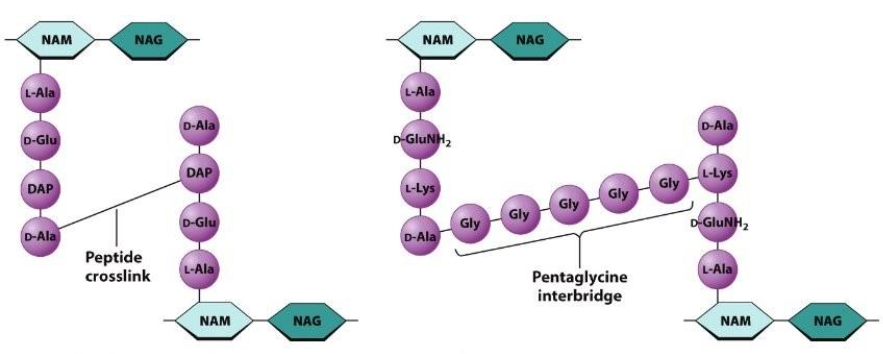
Explain NAM and the it’s 2 forms
Several of the AA associated w/ NAM in peptidoglycan are unusual D forms. D forms are stereoisomers (mirror images) of the I form normally found in biological proteins.
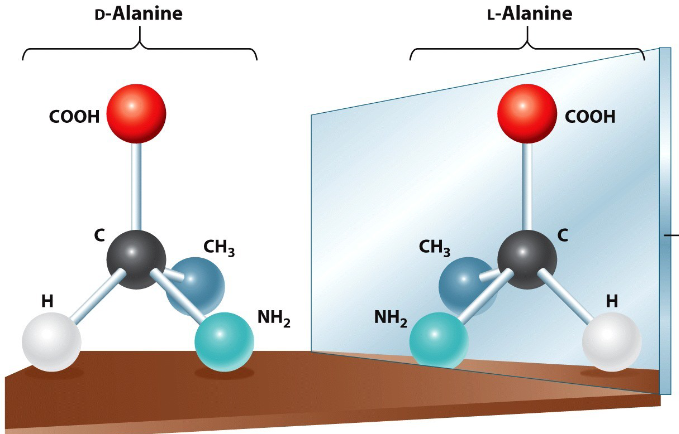
What are the the 2 main enzymes associated w/ the bacterial cell wall?
What is it’s role?
FtsZ forms the Z ring, and that's where cell wall synthesis happens. FtsI catalyzes transpeptidation (formation of peptide crosslinks), and transglycosylase catalyzes the joining of NAM and NAG together via 1,4 glycosidic bonds. Both of these enzymes act on this Z ring
How is the cell degraded?
It is degraded by lysozyme secretions as it cleaves the backbones of peptidoglycans (the ester link). Lysostaphin acts on the crossbridge of certain Staphylococcus species only & affects the pentaglycine in G+.
But w/o the cell wall, the cell cannot resist osmotic pressure changes and will end up rupturing, but pushing the cytoplasm out of the cell. This causes a cell to swell or shrivel.

What do antibiotics do? What do they do & target?
What is antibiotic resistance?
β-lactam antibiotics prevent peptidoglycan crosslinking and inhibit FtsI transpeptidation. They target FtsI, responsible for transpeptidation, which reforms the cell wall.
Antibiotic resistance is when some bacteria produce an enzyme to destroy the critical β-lactam ring structure. A second drug must be added to inhibit the enzyme.
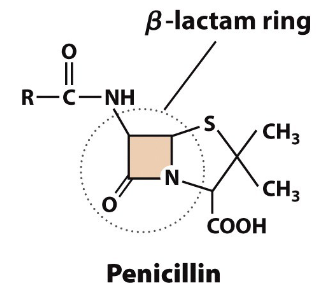
What are G+ cell membranes made of?
Gram + cells have a thick outer layer of peptidoglycan with a narrow periplasmic space. It has negatively charged teichoic acids (polysaccharides) embedded into the peptidoglycan. Those attached to the membrane are lipoteichoic acid (LTA) to anchor cell wall into membrane.
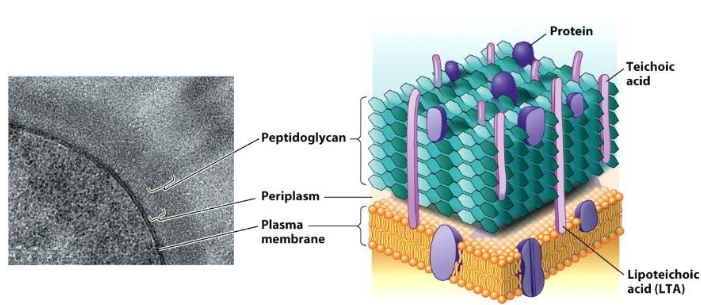
What are G- cell membranes made of?
G- cells have a more complex cell envelope as it includes an outer membrane exterior to the thin peptidoglycan layer. This space b/w them includes the periplasm. The outer membrane consists of a phospholipid bilayer and lipopolysaccharide (LPS).
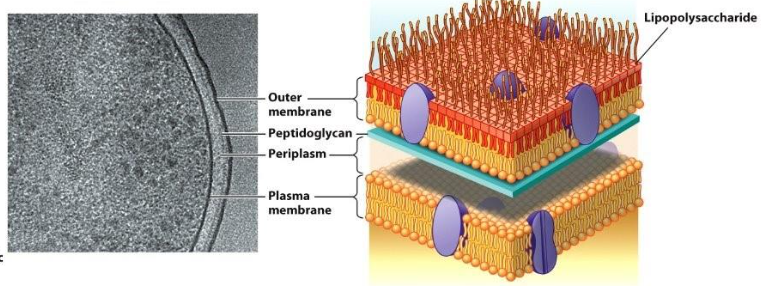
What can be harmful to the G- cells?
LPS from Gram – cells can be harmful. They are made of Lipid A (highly immunogenetic), and an O (outer) side chain of polysaccharides can vary. It is changed by the microbe to evade host immune responses.
How does nutrients get into G+ & G- cells?
What color do G+ and G- turn after staining? How?
G+ have peptidoglycan layers w/ large pores so it can go inside the cell.
G- cells have porins & TonB proteins on the outer membrane. Porin transfers molecules into the periplasmic space. TonB receptors use PMF across the membrane through its high affinity for the molecule.
The Gram stain uses alcohol decolorization, which shrinks the large pores in G+, allowing for the crystal violet to stay. G+ = purple. G- = pink.
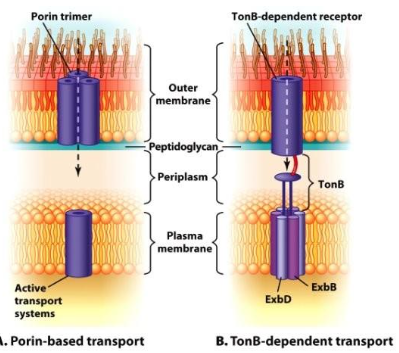
How do molecules leave the G- cell?
Some move from the periplasm to the outside directly, but autotransporters (rare), while some use single-step transport systems (never entering the periplasm).
Type II secretion passes polypeptides through a syringe to the outside of the cell. The flagellar system secretes proteins, but also the subunits are used to create the syringe.
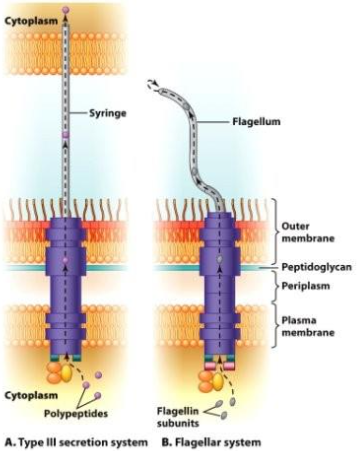
What are the 4 types of organelles found on the bacterial cell surface?
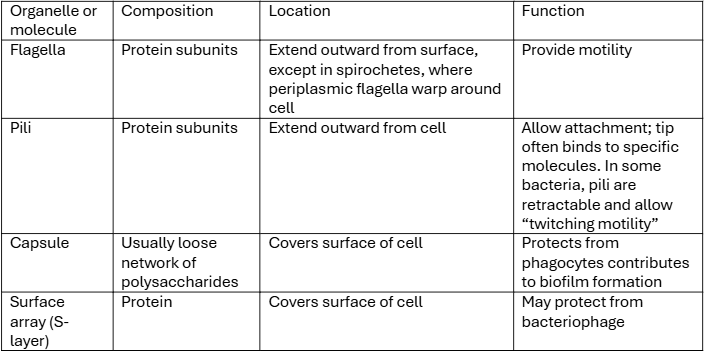
What are flagella?
What are it’s polar arrangements and what are not?
Spiral, hollow, rigid filaments extending from the cell surface. Location and # vary across species. 3 polar arrangements:
Monotrichous: 1 hair
Amphitrichous: 2 hairs
Lophotrichous: many flagella at the end of the cell
Peritrichous: multiple flagella spread over the surface of the cell - not polar arrangement
There are protein anchors for flagella in the cell membrane, cell wall, and outer membrane.
What are the zones of stability of a flagella in a G- cell.
Filament of multiple flagellin proteins
Hook protein portion connects filament to the basal body
Basal bodies are disk-like structures that turn filaments like a propeller
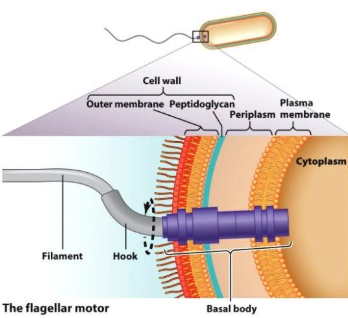
How do flagella move?
The energy to spin a flagellum derived from PMF is expensive. It is a complex structure, and the spinning creates runs and tumbles w/ no steering. But the cell can tell if it is moving in the wrong direction, can change direction, and try again. It is a random orientation for turning and tumbling.
What is the chemical movement called?
What causes this to occur.
Chemical movement is chemotaxis. Chemoreceptor proteins temporally sense changes in the [ ] of attractants or repellents.
A random walk has alternative runs and tumbles resulting in no direction.
Positive chemotaxis is prolonged runs that move a bacterium TOWARDS a chemical. Negative chemotaxis is prolonged runs that move a bacterium AWAY from a cell.
This occurs as flagella.
What is phototaxis, aerotaxis, and osmotaxis?
Phototaxis is light. Aerotaxis is O2. Osmotaxis is osmotic strength.
What are adherence molecules?
They are located outside to cell which allow cells to stick to surface. Pili, fibers of pilin protein, possess other proteins on their tips for sticking.
Function: conjugation, attachment to host cell, motility.
What is stalk?
Stalk is when some microbes will use an extension of the cell envelope, tipped by a holdfast of polysaccharides. It proves extra SA for nutrient absorption.
What are Capsules?
Capsules are thick layers of polysaccharides surrounding some cells. in both G+ and G-. It provides adhesion, defense against host immunity, & protection against desiccation. It can help bacteria from biofilms which provide protection and enhanced survivability in harsh environments.
What are Surface arrays (S-layers)
They have crystalline array of interlocking proteins. It can protect a cell against predation or infection w/ bacteriophages. Found in G+ and G- & can sometimes be the only thing archaea have.